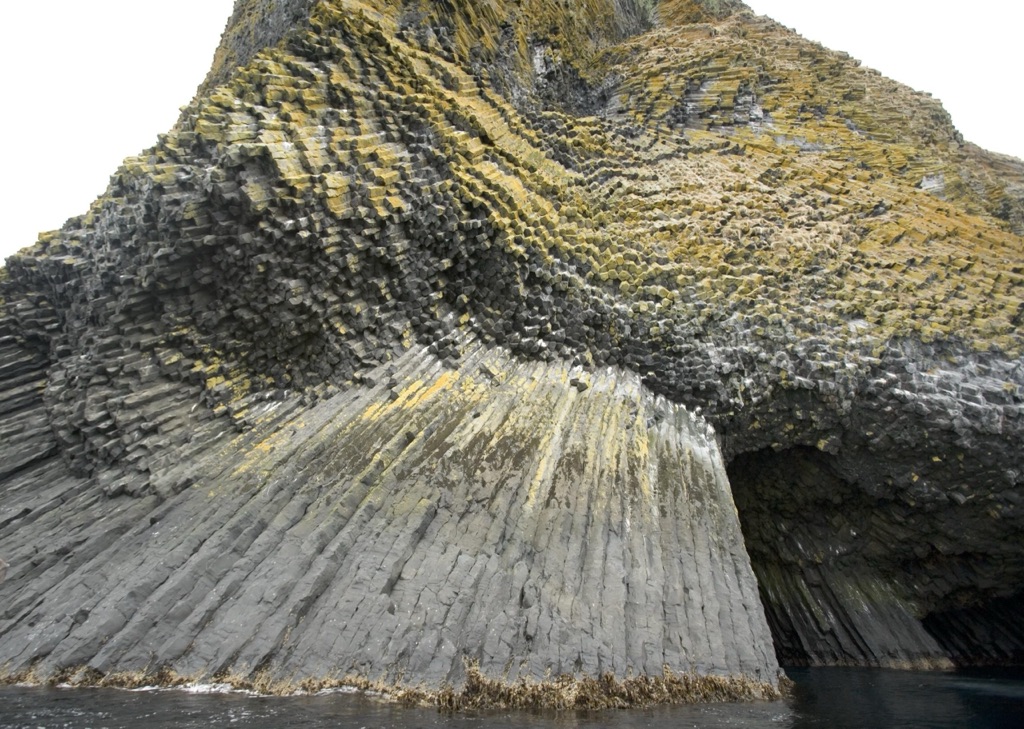Summary
Discovering Akun Island’s Geological Marvel
Akun Island, nestled in Alaska’s Aleutian chain, is home to a majestic natural structure: the Columnar Basalt Cave. This awe-inspiring formation is the result of an ancient volcanic eruption. When the lava cooled rapidly, it contracted and fractured to form the hexagonal columns that line the cave today. Visitors to Akun Island are enchanted by these towering basalt columns, reminiscent of a time when the earth’s fiery forces shaped the landscapes we see now. It is a primary point of interest for geologists and adventurers alike, with its pristine beauty often described as otherworldly.
Get your dose of History via Email
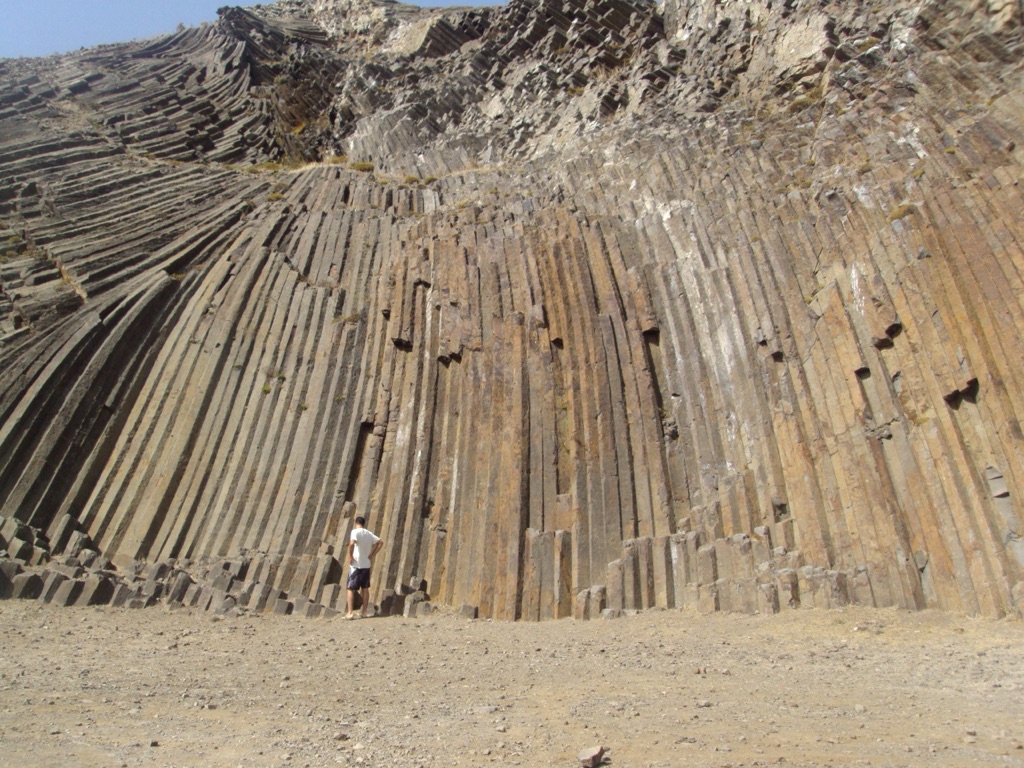
A Sanctuary for Wildlife and Heritage
Beyond geology, Akun Island serves as a protective haven for a variety of wildlife. Its rugged cliffs and undisturbed terrain offer nesting sites for numerous seabird species, while the surrounding waters are rich with marine life such as seals and whales. The Columnar Basalt Cave, with its secluded and tranquil environment, contributes to the island’s ecosystem by providing shelter and breeding grounds. For the native Aleut community, the island and its unique cave features carry cultural significance, representing a connection to their ancestral land and the storytelling passed down through generations.
Embarking on an Unforgettable Expedition of Akun Island Columnar Basalt Cave
Embarking on a journey to Akun Island’s Columnar Basalt Cave promises to be an unforgettable experience. The cave’s remote location means that accessing it is an adventure in itself. Travelers typically reach the island by boat or helicopter, the latter offering breathtaking aerial views of the basalt columns. Once on the island, a guided tour or a carefully planned independent visit paves the way to the cave’s entrance. The sight of the hexagonal patterns towering overhead is humbling as the echoes of dripping water and the call of distant seabirds fill the air, evoking a sense of timelessness and wonder.
Historical Background of Akun Island Columnar Basalt Cave
Akun Island’s Columnar Basalt Cave stands as a geological wonder on the remote island in the Aleutian chain. Formed over millennia, this cave showcases nature’s artistry through striking hexagonal columns. These shapes came to life through the rapid cooling and subsequent cracking of ancient lava flows. Their origin dates back to a time when volcanic activity was the architect of the island’s rugged landscape.
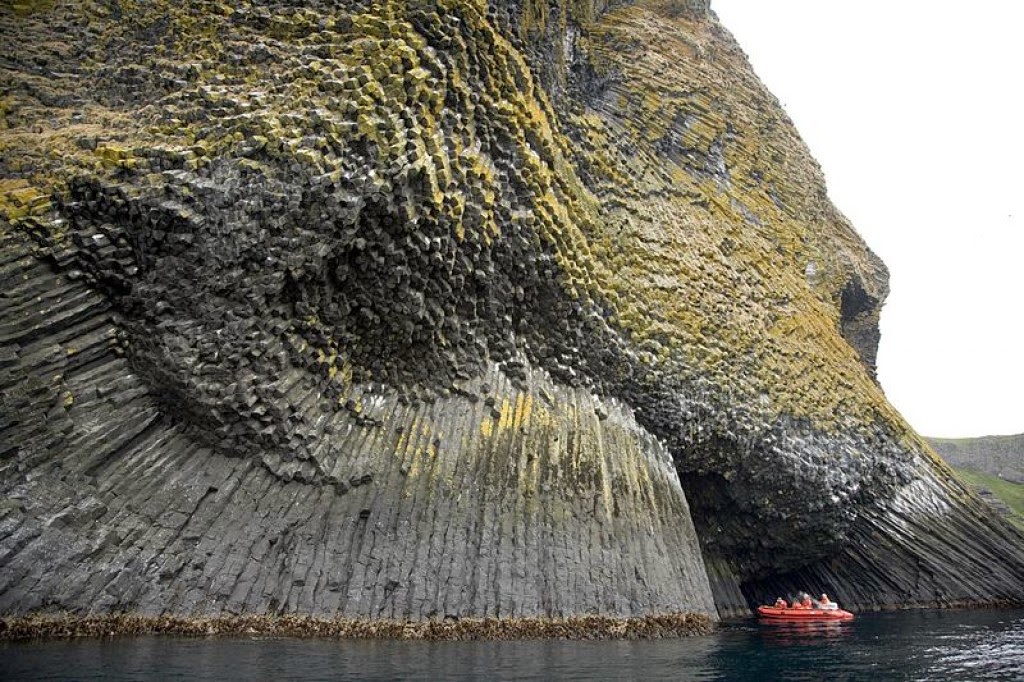
Volcanic Origins and Natural Formations of Akun Island Columnar Basalt Cave
The island’s isolation has preserved the cave’s untouched splendor, keeping its history shrouded in mystery. Geological studies suggest the cave’s basalt structures mirror those found in other volcanic regions around the world. This implies a shared lineage with these distant cousins, tied together by the common thread of eruptive pasts. The basalt columns embody stories of the earth’s fiery power and the slow dance of geological change.
A Rich Tapestry of Aleut Culture
Akun Island is not just a site of scientific intrigue. It holds a special place in the heritage of the Aleut people. For generations, the cave has been woven into their oral history. It’s a place full of myths and legends that tell tales of the island’s formation. The Aleuts have long held the cave and the island as a part of their identity, respecting its pristine condition as a natural treasure.
Preservation and Modern Recognition
In modern times, recognition of the cave’s significance has grown. Conservation groups now work to protect the site from the pressures of tourism and development. Not only for its geological features but also for its cultural heritage. These efforts ensure that the Columnar Basalt Cave remains a page out of time for future generations to appreciate.
The story of Akun Island and its Columnar Basalt Cave is a captivating blend of nature and culture. It beckons historians, scientists, and travelers alike to delve into its depths. To explore the cave is to walk through a portal into the past, gaining a glimpse into the earth’s ancient history and the rich tapestry of human connection to our planet’s natural wonders.
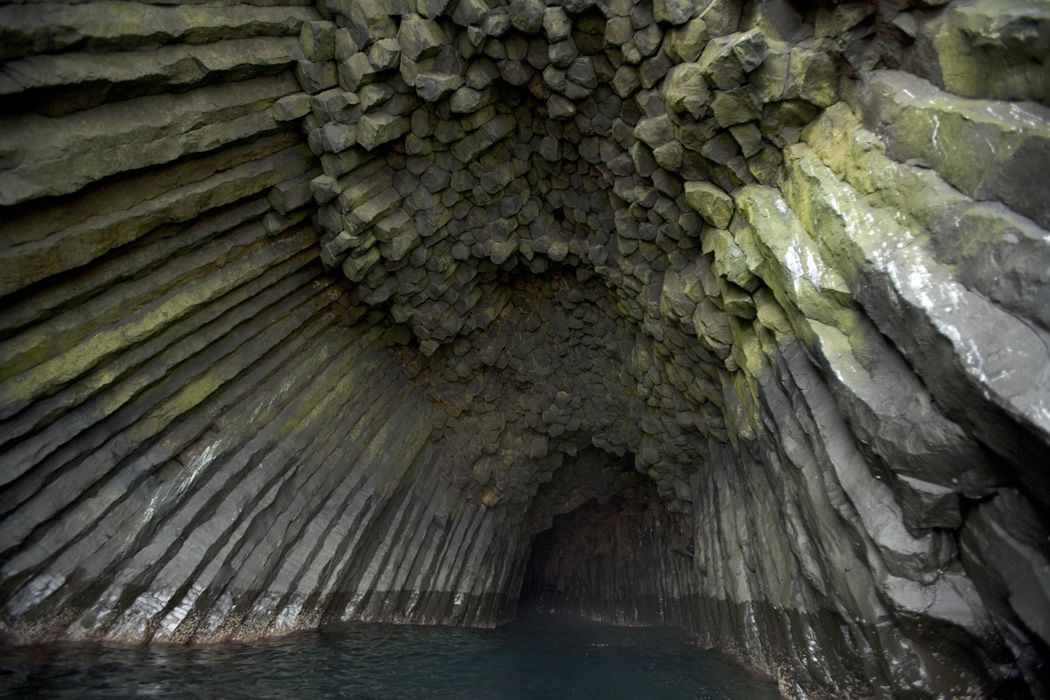
The Discovery of Akun Island Columnar Basalt Cave
A Serendipitous Finding
The Akun Island Columnar Basalt Cave was not discovered through an orchestrated search; rather, chance played a pivotal role. Local fishermen, familiar with the Aleutian waters, stumbled upon the entrance while seeking shelter during a storm in the early 1900s. The sight that greeted them was as unexpected as it was magnificent. They had found themselves within a cavern of symmetrical stone pillars rising from the earth.
Charting the Unknown
Word of the discovery spread among the local communities, and it soon caught the interest of geologists. Initially visited by curious locals and amateur naturalists, it wasn’t long before the scientific community recognized the cave’s significance. By the mid-20th century, formal expeditions began to chart and study the cave, piecing together its volcanic origins and its impact on the surrounding ecology.
Recognition of Natural Heritage of Akun Island Columnar Basalt Cave
The cave’s grandeur and the compelling hexagonal formations quickly asserted its status as a geological jewel within the region. These characteristics earmarked the cave as an important heritage site, leading to increased endeavors to preserve its untouched state. Researchers strived to understand the cave’s formation while staying mindful of its delicate ecosystem.
In time, the cave became a beacon for naturalists and adventurers. The cave’s discovery story became part of its allure, adding to the mystique of the secluded island’s treasure. As explorers set foot in the cave, they not only marveled at the natural wonder but also contributed to its legacy of discovery and adventure.
The journey from an accidental refuge to a celebrated natural landmark encapsulates the essence of the Akun Island Columnar Basalt Cave. Its discovery narrative continues to inspire those who value the intertwining of natural wonders and human history, ensuring it remains a cherished site for many years to come.
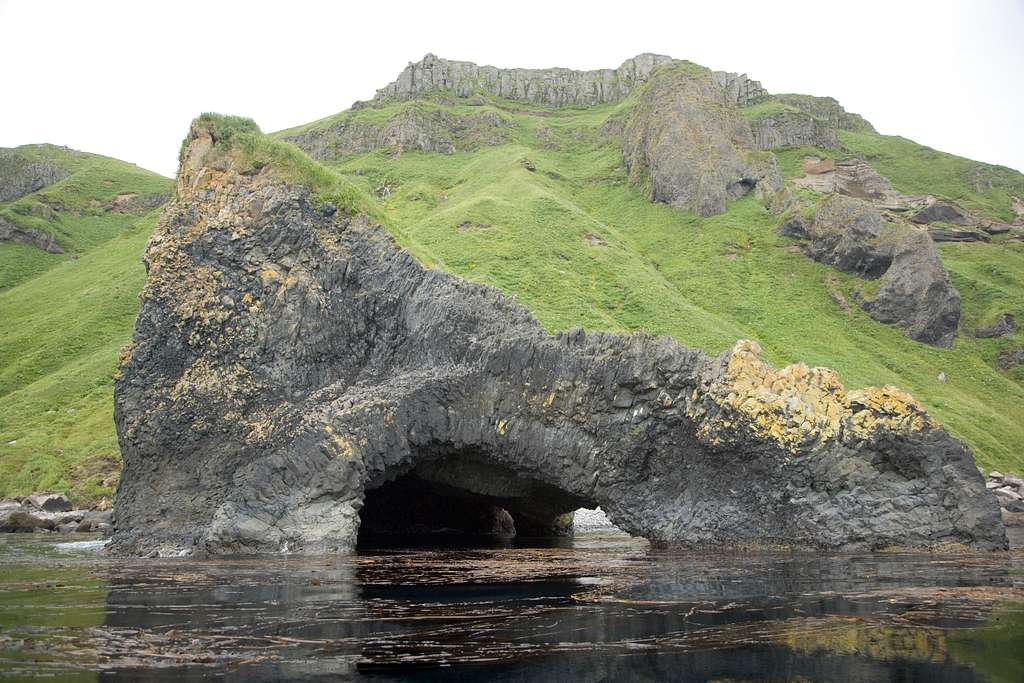
Cultural Significance, Dating methods, Theories and Interpretations
Cultural Heart of the Aleut Community
The Columnar Basalt Cave of Akun Island is not only a geological marvel; it is deeply ingrained in the Aleut culture. For centuries, the Aleut people have revered the cave as a sacred space, intertwining its existence with their myths and rituals. It stands as a spiritual landmark that echoes the voices of their ancestors, cementing a bond between nature and heritage that persists to this day.
Dating the Akun Island’s Columnar Basalt Cave Formation
Although the exact date of the cave’s formation remains elusive, extensive geological studies have provided insight. By studying mineral samples through radiometric dating techniques, scientists estimate the cave’s basalt columns were formed over tens of thousands of years ago. This dating has harnessed the decay of naturally occurring isotopes to unlock the timeline of the cave’s volcanic origins, offering a window into the island’s distant past.
Theories of Geological Development
While the broad strokes of the cave’s history are understood, many details about its formation invite ongoing conjecture and study. Some geologists propose that the unique columnar structure indicates a singular, violent volcanic event. Others suggest a series of eruptions over extended periods might have crafted the cave’s present form, layer by layer. These competing theories drive further research, with each study bringing us closer to understanding the cave’s story.
Interpreting the cave’s formation has transcended pure science, inspiring artists and writers with its natural splendor. To some, the columns are petrified relics of a primordial world. To others, they are symbols of the enduring power of natural processes. Such interpretations reflect our desire to find meaning in the majesty of the natural world.
The Cultural Significance, Dating Methods, Theories, and Interpretations surrounding Akun Island’s Columnar Basalt Cave paint a multifaceted picture. They speak of a place that is not just a scientific curiosity but also a cultural touchstone and a muse for the human spirit. Its story continues to unfold as each explorer, researcher, and visitor adds a new layer to its enduring legacy.
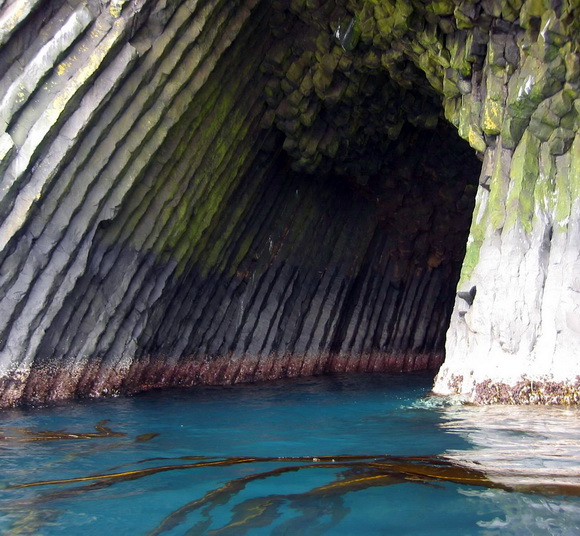
Conclusion and Sources
In the vast tapestry of Earth’s geological and cultural history, the Columnar Basalt Cave of Akun Island emerges as a chapter full of wonder and mystique. Its formation, a storyteller of volcanic fury, now stands still, whispering the ancient tales of the Aleut people. The blending of science with folklore provides a deeper understanding of humanity’s relation to the natural world. Preservation efforts ensure that this site continues to captivate and educate future generations, safeguarding its legacy, and maintaining its position as a natural wonder and cultural artifact.
For further reading and to validate the information presented in this article, the following sources are recommended:
- Geology In: Akun Island Columnar Basalt – Alaska
- Giants Causeway’s Guide: Similar Structures Around The World
Or you can check any of these reputable archaeological and historical texts:
American Geological Institute. (n.d.). How Basalt Columns Form.
Aleutian Islands Working Group. (2020). Akun Island Archaeological Discoveries. Retrieved from
National Park Service. (n.d.). Aleutian World War II National Historic Area. Retrieved from
Smithsonian National Museum of Natural History. (n.d.). Global Volcanism Program. Retrieved from
World Heritage Convention. (n.d.). Aleutian Islands.

